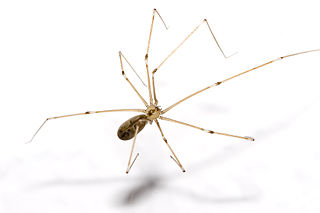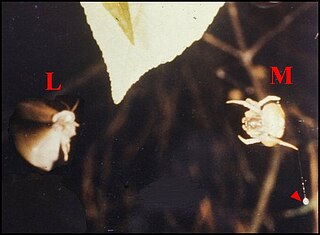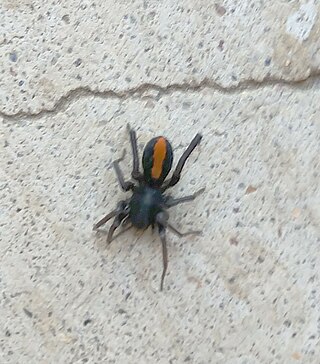
Huntsman spiders, members of the family Sparassidae, are known by this name because of their speed and mode of hunting. They are also called giant crab spiders because of their size and appearance. Larger species sometimes are referred to as wood spiders, because of their preference for woody places. In southern Africa the genus Palystes are known as rain spiders or lizard-eating spiders. Commonly, they are confused with baboon spiders from the Mygalomorphae infraorder, which are not closely related.

The Araneomorphae are an infraorder of spiders. They are distinguishable by chelicerae (fangs) that point diagonally forward and cross in a pinching action, in contrast to the Mygalomorphae, where they point straight down. Araneomorphs comprise the vast majority of living spiders.

The Pholcidae are a family of araneomorph spiders. The family contains more than 1,800 individual species of pholcids, including those commonly known as cellar spider, daddy long-legs spider, carpenter spider, daddy long-legger, vibrating spider, gyrating spider, long daddy, and skull spider. The family, first described by Carl Ludwig Koch in 1850, is divided into 94 genera.

Velvet spiders are a small group of spiders almost entirely limited to the Old World, with the exception of one species known from Brazil. In Europe, some are commonly called the ladybird spiders.

Psechridae is a family of araneomorph spiders with about 70 species in two genera. These are among the biggest cribellate spiders with body lengths up to 2 centimetres (0.79 in) and funnel webs more than 1 metre in diameter.

The Majoidea are a superfamily of crabs which includes the various spider crabs.

Microlinyphia pusilla is a species of spider belonging to the family Linyphiidae. It has a Holarctic distribution.

Crab fisheries are fisheries which capture or farm crabs. True crabs make up 20% of all crustaceans caught and farmed worldwide, with about 1.4 million tonnes being consumed annually. The horse crab, Portunus trituberculatus, accounts for one quarter of that total. Other important species include flower crabs, snow crabs (Chionoecetes), blue crabs, edible or brown crabs, Dungeness crab, and mud crabs, each of which provides more than 20,000 tonnes annually.
Enoplognatha marmorata, the marbled cobweb spider, is a species of cobweb spider in the family Theridiidae. It is found in North America.

Habronattus signatus is a species of jumping spider in the family Salticidae. It is found in the United States and Mexico.

Mastophora cornigera is a species of orb weaver in the spider family Araneidae. It is found in a range from the United States to Nicaragua. Like all known species of the genus Mastophora, adult females are bolas spiders, capturing their prey with one or more sticky drops at the end of a single line of silk rather than in a web. Males and juvenile females capture their prey directly with their legs.

Mastophora bisaccata is a species of orb weaver in the spider family Araneidae. It is also known as Mastaphora obesa. It is found in the United States and Mexico. Like all known species of the genus Mastophora, adult females are bolas spiders, capturing their prey with one or more sticky drops at the end of a single line of silk rather than in a web. Males and juvenile females capture their prey directly with their legs.
Phidippus bidentatus is a species of jumping spider. It is found in a range from the United States to Costa Rica.
Geolycosa missouriensis, the burrowing wolf spider, is a species of wolf spider in the family Lycosidae. It is found in the United States and Canada. They are most active in summer and hunt similar to the trapdoor spiders, lying in wait in their burrows until they sense the arrival of prey through vibrations in the ground.
Arctosa sanctaerosae, the Santa Rosa wolf spider, is a species of wolf spider in the family Lycosidae. It is found in the United States.
Microlinyphia impigra is a species of sheetweb spider in the family Linyphiidae. It is found in North America, Europe, Caucasus, a range from Russia, and China.

Thanatus vulgaris is a species of running crab spider in the family Philodromidae. It is found in North America, Europe, North Africa, Turkey, Israel, Caucasus, a range from Russia, Central Asia, China, and Korea.
Tibellus duttoni is a species of running crab spider in the family Philodromidae. It is found in the United States and Mexico.
Mastophora leucabulba is a species of orb weaver in the spider family Araneidae. It is found in a range from the United States to Honduras. Like all known species of the genus Mastophora, adult females are bolas spiders, capturing their prey with one or more sticky drops at the end of a single line of silk rather than in a web. Males and juvenile females capture their prey directly with their legs.

Castianeira crocata is a species of true spider in the family Corinnidae, sometimes called by the common name red stripe spider. It is found in the United States. Though its body shape is quite different, its characteristic black body and red-marked back puts it at risk of being mistaken for a black widow spider.













